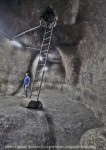A large rock-hewn water reservoir dating from the First Temple period was discovered in archaeological excavations conducted in the Jerusalem Archaeological Garden at the foot of Robinson’s Arch.
Eli Shukron, excavation director on behalf of the Israel Antiquities Authority, claims that this discovery makes it clear that “Jerusalem’s water consumption during the First Temple period was not solely based on the Gihon Spring, but also relied on public reservoirs”
The excavation, during the course of which the reservoir was discovered, is part of a dig of Jerusalem’s Second Temple period drainage channel. It appears that during work on this enormous engineering enterprise its builders had to remove earlier structures that were situated along the route of the channel and dig through existing rock-hewn installations that were located along it’s course. An extraordinary large water reservoir covered with several layers of plaster, probably dating from the First Temple period, was exposed in recent weeks.
The reservoir has an approximate capacity of 250 cubic meters and is therefore one of the largest water reservoirs from the First Temple period to be discovered so far in Jerusalem. It is presumed to have been a reservoir used for general use. This is the first time that a water reservoir of this kind has been exposed in an archaeological excavation.
The exposure of the impressive water reservoir that lies below Robinson’s Arch joins a series of finds that were uncovered during recent excavations in this region of the city.



